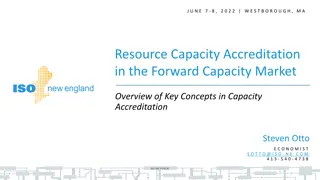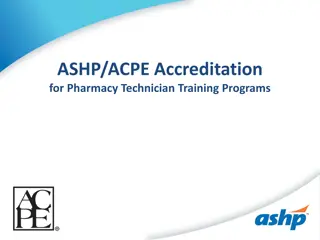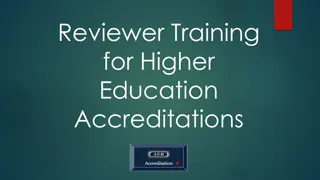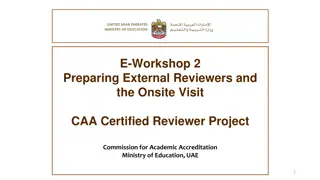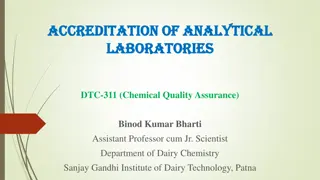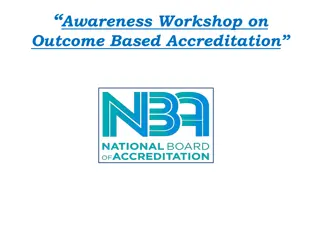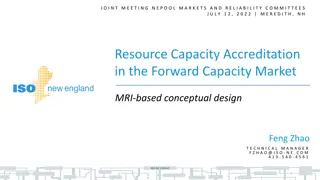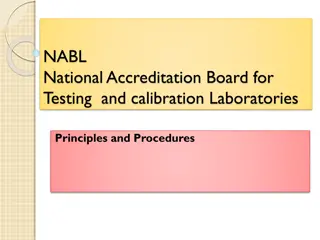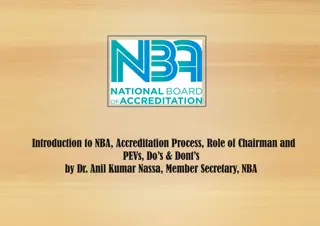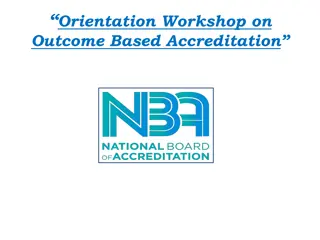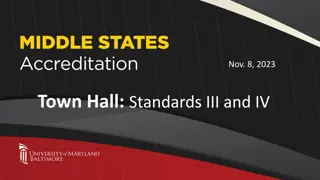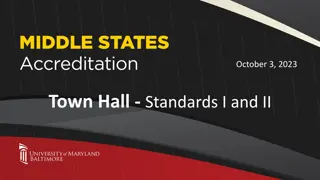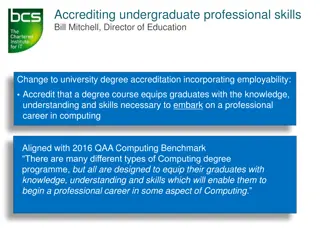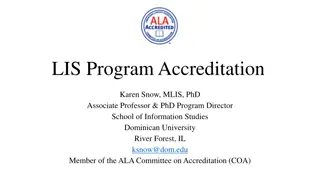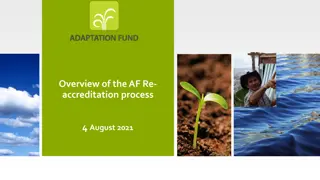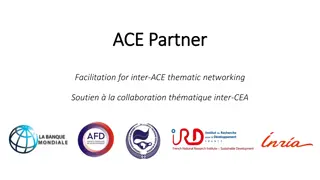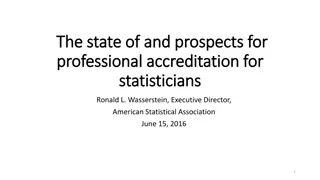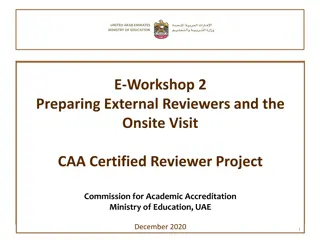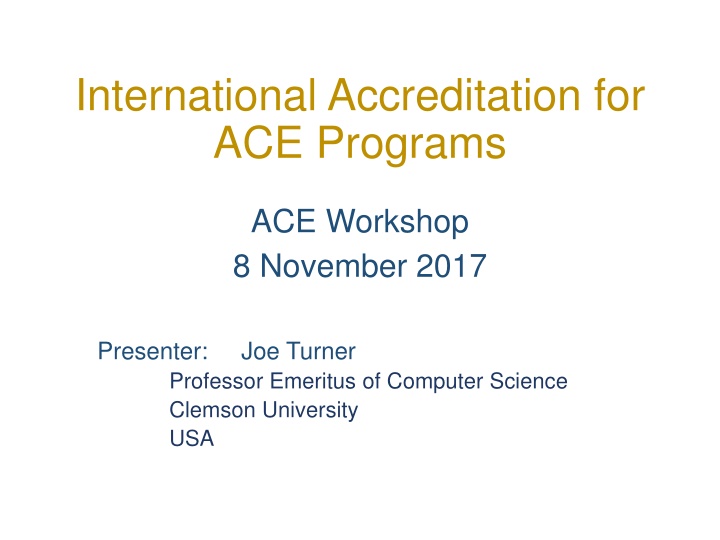
International Accreditation for ACE Programs Workshop
Retired Professor of Computer Science from Clemson University, Joe Turner presents on international accreditation at the ACE Workshop. Learn about ABET requirements, international accreditation options, and more in this informative session.
Download Presentation

Please find below an Image/Link to download the presentation.
The content on the website is provided AS IS for your information and personal use only. It may not be sold, licensed, or shared on other websites without obtaining consent from the author. If you encounter any issues during the download, it is possible that the publisher has removed the file from their server.
You are allowed to download the files provided on this website for personal or commercial use, subject to the condition that they are used lawfully. All files are the property of their respective owners.
The content on the website is provided AS IS for your information and personal use only. It may not be sold, licensed, or shared on other websites without obtaining consent from the author.
E N D
Presentation Transcript
International Accreditation for ACE Programs ACE Workshop 8 November 2017 Presenter: Joe Turner Professor Emeritus of Computer Science Clemson University USA
Who am I? (1) Retired Professor of Computer Science, Clemson University Former Professor and Dean of Information Systems, Zayed University (UAE) Over 30 years of experience in computing and engineering accreditation with ABET and CSAB Multiple officer/leadership positions Chair of more than 30 evaluation teams, member of 4 more ACE Workshop 8 November 2017 2
Who am I? (2) Initial Chair of Seoul Accord, an international mutual recognition accord among accreditors for computing programs. Substantial consulting experience in preparation for ABET accreditation Chaired a team of consultants that reviewed some engineering programs at three ACEs relative to preparation for possible ABET accreditation. ACE Workshop 8 November 2017 3
Intended outcomes for this session Participants will have an introduction to the requirements to obtain accreditation by ABET, and actions needed to prepare for an accreditation review. Participants will have an introduction to options for international accreditation of STEM programs. ACE Workshop 8 November 2017 4
Some definitions In this presentation, the following definitions apply: Course: A collection of student learning activities that takes place during a semester or other term. Program: A collection of course requirements that leads to granting of a degree or certification by an educational institution. Student outcomes: What students are expected to know and be able to do at the time of graduation from a program. ACE Workshop 8 November 2017 5
Session outline 1. What is ABET? 2. ABET Criteria for Accreditation 3. ABET Accreditation Process 4. International Accreditation for Computing and Engineering Programs 5. Final Notes ACE Workshop 8 November 2017 6
Session outline 1. What is ABET? 2. ABET Criteria for Accreditation 3. ABET Accreditation Process 4. International Accreditation for Computing and Engineering Programs 5. Final Notes ACE Workshop 8 November 2017 7
What is ABET? (1) ABET is a US-based organization that Is non-governmental and non-profit. Accredits tertiary-level (university) programs in Applied and natural science Computing Engineering Engineering technology Does not accredit departments, colleges, or other administrative units. ACE Workshop 8 November 2017 8
What is ABET? (2) Has been accrediting engineering programs since 1932 Currently accredits 3,852 programs at 776 colleges and universities in 31 countries 677 programs (18%) at 122 colleges and universities (16%) in 30 countries outside the US Web site: www.abet.org ACE Workshop 8 November 2017 9
ABET Commissions ABET has four commissions that carry out the accreditation processes: Applied and Natural Science Accreditation Commission (ANSAC) Bachelor, Master, 2-year Computing Accreditation Commission (CAC) Bachelor only Engineering Accreditation Commission (EAC) Bachelor, Master Engineering Technology Accreditation Commission (ETAC) Bachelor, 2-year, 3-year ACE Workshop 8 November 2017 10
ABET commission determination The name (title) of a program determines the commission that must review and make an accreditation decision for the program. Examples: Computer science: CAC Computer engineering: EAC Computer engineering technology: ETAC Industrial Hygiene: ANSAC Information Systems Engineering: CAC and EAC ACE Workshop 8 November 2017 11
Session outline 1. What is ABET? 2. ABET Criteria for Accreditation 3. ABET Accreditation Process 4. International Accreditation for Computing and Engineering Programs 5. Final Notes ACE Workshop 8 November 2017 12
Basis for determining whether a program is accredited Primary: ABET Criteria for program accreditation. Published, publicly available. A program can be accredited only if every applicable criterion and policy is satisfied. ACE Workshop 8 November 2017 13
Criteria topics ABET Criteria state requirements for: 1. Students 2. Program Educational Objectives 3. Student Outcomes 4. Continuous Improvement 5. Curriculum 6. Faculty 7. Facilities 8. Institutional Support ACE Workshop 8 November 2017 14
Outcomes-Based Criteria ABET criteria are outcomes-based The focus is on requirements to: 1. Establish a set of student outcomes for the program. 2. Carry out effective processes to assess the attainment level of the outcomes by students. 3. Use the results from the assessment of student outcomes attainment in a continuous improvement process for the program. ACE Workshop 8 November 2017 15
Continuous Improvement Processes Cycle 16 For each student outcome: Evaluate assessment data Identify sources of assessment data Collect assessment data Action needed ? No Determine action needed Implement action Yes
17 Continuous Improvement Notes Details on ways to implement good continuous improvement processes require far more time than is available today. ABET provides multi-day workshops on implementing good continuous improvement processes. It is difficult to implement good processes without knowledgeable help.
Session outline 1. What is ABET? 2. ABET Criteria for Accreditation 3. ABET Accreditation Process 4. International Accreditation for Computing and Engineering Programs 5. Final Notes ACE Workshop 8 November 2017 18
ABET Accreditation Process The primary sources of information for an ABET program review are: A self-study prepared in advance by program faculty. An onsite visit to the program by a review team. The commission uses the findings from a program review to determine the proper accreditation action for the program. ACE Workshop 8 November 2017 19
Self-Study The self-study provides discussion and documentation on how the program satisfies each criterion. It is the responsibility of the program to explain and document how each criterion is satisfied. Preparation of the self-study is a substantial amount of work. At least six months (part-time), and preferably more, should be allocated to self-study preparation. ACE Workshop 8 November 2017 20
Self-Study Questionnaire A self-study questionnaire for each commission is available on the ABET website. Word document Template for self-study The self-study questionnaire can be used for independent self evaluation of a program relative to ABET requirements, as well as for producing a self-study to submit to ABET for an accreditation review. ACE Workshop 8 November 2017 21
Onsite review visit During a three-day onsite (campus) visit, an ABET review team will: Conduct interviews with faculty, students, and administrators. Review course materials. Review materials documenting outcomes assessment and evaluation, and their use in continuous improvement. Observe laboratories and other program facilities. ACE Workshop 8 November 2017 22
Materials display During the onsite review visit, the program must provide a display of course and assessment materials including: Textbook, syllabus, copies of exams, homework, projects, etc. for each major course. Samples of graded student work for each course. Documentation for continuous improvement process results, including outcomes assessment, during the past 3-5 years. ACE Workshop 8 November 2017 23
Frequency of reviews Once accredited, a program must have another full review every six years in order to retain its accreditation. A partial review in two years is required if a weakness is found during a review. ACE Workshop 8 November 2017 24
Accreditation process details The details of the accreditation process and associated requirements are given in the ABET Accreditation Policies and Procedures Manual (APPM), available on the ABET web site. ACE Workshop 8 November 2017 25
Session outline 1. What is ABET? 2. ABET Criteria for Accreditation 3. ABET Accreditation Process 4. International Accreditation for Computing and Engineering Programs 5. Final Notes ACE Workshop 8 November 2017 26
Accreditation Accords There are international mutual-recognition accreditation accords for computing and engineering programs: Seoul Accord Computing Professional Washington Accord Professional Engineer Sydney Accord Engineering Technologist Dublin Accord Engineering Technician An accord consists of accreditation organizations that mutually recognize the accreditation of all accord members as being substantially equivalent for preparing graduates to begin professional practice. ACE Workshop 8 November 2017 27
Accreditation Accords and outcomes-based accreditation The computing and engineering accords base substantial equivalency on a set of Graduate Attributes. Graduate attributes are essentially outcomes that are expected of graduates of any program accredited by accord members. Each signatory (member) of an accord is expected to ensure that graduates of its accredited programs attain the specified graduate attributes for the accord. All signatories of the computing and engineering accords have established, or are establishing, outcomes-based criteria for accreditation. ACE Workshop 8 November 2017 28
Alternatives to ABET for international accreditation Each of the accords has a website listing contact information for the accord members: Seoul Accord (computing): www.seoulaccord.org Washington Accord (engineering) www.ieagreements.org Some of the accord members conduct accreditation outside their home country, and some accredit master s programs. ACE Workshop 8 November 2017 29
Advantages of international program accreditation Accreditation by a recognized international accreditation organization: Certifies that graduates of the program are prepared to enter the profession associated with the program. Makes the program more attractive to international students. Facilitates mobility by graduates of the program in international work. ACE Workshop 8 November 2017 30
Session outline 1. What is ABET? 2. ABET Criteria for Accreditation 3. ABET Accreditation Process 4. International Accreditation for Computing and Engineering Programs 5. Final Notes ACE Workshop 8 November 2017 31
Summary (1) Preparing for an ABET accreditation review is a lot of work. Program modifications are usually required to implement good continuous improvement processes and to bring the curriculum into compliance with the criteria. Additional faculty and laboratory facilities may also be needed. ACE Workshop 8 November 2017 32
Summary (2) Becoming ready for an ABET review can require more than one year. Graduates at the time of accreditation must have an accreditable program of study. Implementing good outcomes-based continuous improvement process requires a lot of time. It is better to prepare well on a reasonable time schedule than to attempt to complete preparations in less time than needed for a high-quality result. ACE Workshop 8 November 2017 33
Observations on preparing for initial ABET accreditation (1) Almost all programs, including African programs, require substantial work in: Designing and implementing adequate outcomes assessment and continuous improvement processes. Establishing mechanisms for interacting with industry and graduates, and obtaining input on employer needs for the capabilities of graduates. For engineering programs, implementing an adequate major engineering design experience. ACE Workshop 8 November 2017 34
Observations on preparing for initial ABET accreditation (2) Significant curriculum modifications may be needed. Some lab improvements may be needed. Especially safety procedures. The cost of ABET accreditation for non-US programs is substantial. Details are on the ABET website. ACE Workshop 8 November 2017 35
ABET acceptance of a request for evaluation Programs desiring an ABET review for possible accreditation must submit a Request for Evaluation. ABET will decide whether to perform the evaluation based on whether the program meets the APPM requirements for eligibility, and whether the health and safety conditions are acceptable for a review team site visit. ACE Workshop 8 November 2017 36
Resources ABET web site: http://www.abet.org ABET workshops On outcomes assessment and continuous improvement Information on the ABET website ABET Symposium Annual (April) symposium on topics related to ABET accreditation Currently held in the USA Information on the ABET website ACE Workshop 8 November 2017 37

